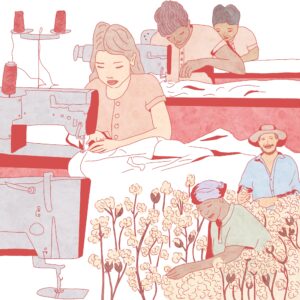Bringing textile production back to the US, from fibre to finished garment: abandoned in the 1990s due to relocation to Asia, it now seems time to bring this industry back to the country. Provided it can be done with unionized, well-paid workers, American-sourced materials and a low-impact industry.
This is discussed by Rachel Slade, author of the book ‘Making it in America‘: an in-depth analysis of the reasons that led to the disappearance of the manufacturing industry in the United States and which also analyses the reasons that could lead to its return today.
There is someone who has already started down that road: Ben and Whitney Waxman launched the clothing brand ‘American Roots almost ten years ago with that very aim. A complicated path, but a possible one.
Rachel Slade in this interview helped me better understand why this might be the right time to return to thinking about ‘full US-made’ clothing production.
Your book tells us an important piece of American economic history, the effects of globalisation and the country’s loss of manufacturing capacity. What was behind the decision to relocate production?
In the 1980s, the US’s biggest corporations, banks, and financiers identified offshoring as a way to dramatically increase profits while dodging union contracts. They framed the issue within the language of “free trade,” arguing that if the US removed all barriers to international production, American brands could cut labor costs while offering Americans significantly cheaper products. Most policymakers thought this sounded like a win-win. George H.W. Bush initiated free trade talks with Mexico and Canada, and Bill Clinton signed the North American Free Trade Agreement (NAFTA) into law in 1992, with bipartisan support. Labor unions and environmentalists anticipated a massive loss of domestic manufacturing jobs and environmental issues, and tried to incorporate language in the agreement to protect workers and ecologies, but to no avail. The updated agreement, USMCA, includes more of that language.
So the free trade policy is actually responsible for the emptying of factories. Tales that between 1994 and 2013, five million American manufacturing jobs disappeared, and apparel production was one of the first industries to be moved overseas. What were these jobs replaced with?
The actual number of lost jobs is unknown, but let’s assume the five million number is in the ballpark. That’s an astonishing loss, a cataclysmic event, which triggered the gutting of towns across America, the opioid crisis, and a complete cultural shift. People felt righteous anger; they felt their country had sold them out. While many women were able to find lower paid work in the service sector, the data shows that men who lost manufacturing jobs had a harder time finding work or adjusting to the new, post-manufacturing economy. Many lost their pensions and struggled to recover financially and emotionally. I have no doubt that there is a direct link between offshoring and the recent rise of the right-wing ideology in American politics.
Please, tell me the story of American Roots, a brand that since its origins has tried to realize the dream of “fully made in the USA”. What were the main obstacles in this journey?
I reported on a small company manufacturing apparel in Maine, the northeasternmost state in the nation. Maine has a much older population than average, so the company’s first obstacle was finding and training a workforce. They put ads in local networks and ended up attracting so-called “New Americans”–recent arrivals and/or asylum-seekers from places such as the Democratic Republic of Congo, Angola, and Iraq. The second obstacle American Roots faced was building a supply chain in an industry that had been decimated by offshoring. And finally, they needed to find buyers willing to spend more for their American-made apparel, which was generally more expensive than goods made in Asia and Central America.
But are we so sure that buying “Made in USA” means making an ethical purchase? This is also a common theme with other manufacturing countries, such as Italy. What is the situation of garment workers in the USA today?
As one manufacturer recently said to me, only wealthy countries with resources and political will can adequately support workers and the environment. Unfortunately, there are certainly examples of apparel workers in the US being exploited. But in the US, they have the legal right to organize, and they are doing so in ever greater numbers. As workers organize, they are lobbying lawmakers to expand protections and enforce existing laws. An excellent example of this can be found in California where pay-by-piecework is now banned. Advocates showed how piecework pay was an easy way for companies to commit wage theft, and lawmakers acted. The minimum wage was also raised.
All laws designed to protect the environment and workers increase the cost of manufacturing, which answers the question: Why are so many goods from Asia so impossibly cheap?
There is the political will to create a fully made in the USA clothing industry, from fiber to finished product. In your opinion is it possible and in what time frame?
In the US, we have tremendous pride in our manufacturing traditions, just as you do in Italy, where Italian-made is synonymous with quality. In 2024, there is an exciting group of entrepreneurs working to rebuild the apparel industry. But they’re fighting against tariff-free imports, some made by enslaved workers, shipped at negligible cost, straight into Americans’ homes. Policymakers need to level the playing field by closing loopholes that allow millions of tariff-free packages per day to enter the US and undermine our well-regulated industries. That’s the battle domestic manufacturers are currently waging.
But there is much resistance on Wall Street and in the minds of those who believe that regulations harm the free market. To those naysayers, I say, there is no free market when you take into account how other countries, especially China, are manipulating currencies and markets to undermine other nations’ manufacturing capabilities and ultimately create a crippling dependency on foreign goods. That’s the crisis that all nations face at this moment.
Cover Foto di Luke Michael su Unsplash






